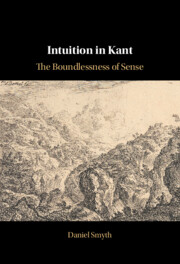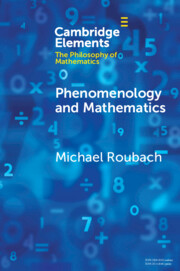94 results
3 - An Apperceptive Approach to the Transcendental Aesthetic
-
- Book:
- Intuition in Kant
- Published online:
- 07 March 2024
- Print publication:
- 14 March 2024, pp 73-109
-
- Chapter
- Export citation
5 - Infinity, Discursivity, Givenness
-
- Book:
- Intuition in Kant
- Published online:
- 07 March 2024
- Print publication:
- 14 March 2024, pp 132-172
-
- Chapter
- Export citation
2 - Synthetic Judgment and Intuition
-
- Book:
- Intuition in Kant
- Published online:
- 07 March 2024
- Print publication:
- 14 March 2024, pp 44-72
-
- Chapter
- Export citation
7 - A Stufenleiter of Kantian Intuition, Part I
-
- Book:
- Intuition in Kant
- Published online:
- 07 March 2024
- Print publication:
- 14 March 2024, pp 194-216
-
- Chapter
- Export citation

Intuition in Kant
- The Boundlessness of Sense
-
- Published online:
- 07 March 2024
- Print publication:
- 14 March 2024
Chapter 1 - V. S. Naipaul Aesthetic Ideology and World Literature
-
- Book:
- V. S. Naipaul and World Literature
- Published online:
- 01 February 2024
- Print publication:
- 08 February 2024, pp 13-29
-
- Chapter
- Export citation
6 - Beyond (social) science
-
- Book:
- Re-imagining Social Work
- Published online:
- 07 December 2023
- Print publication:
- 21 December 2023, pp 106-122
-
- Chapter
- Export citation
Multidimensional intuitive–analytic thinking style and its relation to moral concerns, epistemically suspect beliefs, and ideology
-
- Journal:
- Judgment and Decision Making / Volume 18 / 2023
- Published online by Cambridge University Press:
- 18 December 2023, e42
-
- Article
-
- You have access
- Open access
- HTML
- Export citation
Chapter 5 - In Defense of How Things Seem
-
- Book:
- Do the Humanities Create Knowledge?
- Published online:
- 10 November 2023
- Print publication:
- 07 December 2023, pp 107-136
-
- Chapter
- Export citation

Phenomenology and Mathematics
-
- Published online:
- 27 November 2023
- Print publication:
- 21 December 2023
-
- Element
- Export citation
Chapter 1 - We Know More Than We Can Tell
-
- Book:
- The Intelligence of Intuition
- Published online:
- 28 September 2023
- Print publication:
- 12 October 2023, pp 1-18
-
- Chapter
- Export citation
Chapter 6 - Embodied Heuristics
- from Part II - Intuition and Its Intelligence
-
- Book:
- The Intelligence of Intuition
- Published online:
- 28 September 2023
- Print publication:
- 12 October 2023, pp 109-124
-
- Chapter
- Export citation
3 - Learning Science
-
- Book:
- The Philosophy and Practice of Science
- Published online:
- 17 September 2023
- Print publication:
- 31 August 2023, pp 18-59
-
- Chapter
- Export citation
Chapter 6 - Movement, Duration, Rhythm
- from Part II - Dialogue, Movement, Ecology
-
- Book:
- The Philosophy of Literary Translation
- Published online:
- 29 July 2023
- Print publication:
- 10 August 2023, pp 131-185
-
- Chapter
- Export citation
8 - Moral Perception and Singular Moral Judgment
- from Part III - Moral Knowledge and Normative Realism
-
- Book:
- Of Moral Conduct
- Published online:
- 08 June 2023
- Print publication:
- 22 June 2023, pp 170-184
-
- Chapter
- Export citation
Chapter 8 - Unpacking Intuitive and Analytic Memory Sampling in Multiple-Cue Judgment
- from Part II - Sampling Mechanisms
-
-
- Book:
- Sampling in Judgment and Decision Making
- Published online:
- 01 June 2023
- Print publication:
- 15 June 2023, pp 177-204
-
- Chapter
- Export citation
4 - A Way Ahead
- from Part I - Taking Stock of Evidence-Based Policing
-
-
- Book:
- The Future of Evidence-Based Policing
- Published online:
- 01 June 2023
- Print publication:
- 15 June 2023, pp 64-82
-
- Chapter
- Export citation
Chapter 3 - Metaphysical Deductions
- from Part II - The Method of Transcendental Philosophy
-
- Book:
- Kant's <I>Critique of Pure Reason</I> and the Method of Metaphysics
- Published online:
- 11 May 2023
- Print publication:
- 25 May 2023, pp 75-121
-
- Chapter
- Export citation
Chapter 3 - A Geometric Frame of Mind
-
- Book:
- Coleridge and the Geometric Idiom
- Published online:
- 23 February 2023
- Print publication:
- 16 March 2023, pp 78-113
-
- Chapter
- Export citation
3 - Jacobi on the Nature of Mind and Intuitive Certainty
- from Part I - The Critique of Reason: Debates on Rationalism, Empiricism, and Skepticism
-
-
- Book:
- Friedrich Heinrich Jacobi and the Ends of the Enlightenment
- Published online:
- 09 February 2023
- Print publication:
- 16 February 2023, pp 49-65
-
- Chapter
- Export citation



